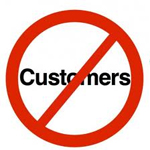 This month we have been blessed to welcome aboard two new clients, one of those is Pieter Berkelaar who runs WA Print Works (a commercial print shop out of Albany in WA). Because Pieter has all the facilities to print and distribute his own newsletter each month, we just assist with the writing, design and strategy.
This month we have been blessed to welcome aboard two new clients, one of those is Pieter Berkelaar who runs WA Print Works (a commercial print shop out of Albany in WA). Because Pieter has all the facilities to print and distribute his own newsletter each month, we just assist with the writing, design and strategy.
I received a few questions from Pieter the other day about the envelope and thought that the answers would be relevant to anyone, not just for newsletters, but any form of direct mail. So here are the questions and the answers I gave Pieter.
Do you send out newsletters folded in a DL envelope or flat in a C4 size envelope?
We use DL size envelopes and folded the newsletters down to DL, primarily for the cheaper postage rates more than anything else. C4 is perfectly fine also, but it is double the price in postage. You’ll find that if you do decide to use C4 envelopes that they will stand out more in the mailbox and be more likely to be opened and read.
Do you have logos and advertising printed on envelope?
This is a tricky one, and the answer is “sometimes” – We do for special occasions like valentine’s day or Christmas, but usually we use a hand-written font to give it a more anonymous feel to it. If you can make it appear as though it was sent by a friend or grandma then it will get opened with excitement and anticipation as opposed to an envelope with a logo that looks like it could be a bill or advertising.
Would you use barcoding for cheaper postage rates?
We don’t, only because once again it loses the ‘could be from grandma’ effect of the newsletter. – Barcoded newsletters basically scream – “We bulk mail this and you are on a database” where the handwritten with the live stamp is more of “we hand-selected you and here’s a special gift we sent you”.
In all honesty, as absurd as it sounds, we find that these small things actually make a noticeable difference to the readership and responses we get from the readers. Hopefully these few tips shed some light on the best way to use envelopes in your marketing.



 Somewhere along the line being a Nerd became cool. Beauty and The Geek and The Big Bang Theory have become staples the country’s nightly television viewing (I challenge you to find a night where Big Bang isn’t on).
Somewhere along the line being a Nerd became cool. Beauty and The Geek and The Big Bang Theory have become staples the country’s nightly television viewing (I challenge you to find a night where Big Bang isn’t on). It has been a fun 12 months for us here at Newsletter Marketing Systems.
It has been a fun 12 months for us here at Newsletter Marketing Systems.
 From a long time now we have been in the business of helping clients get more repeat business and referrals.
From a long time now we have been in the business of helping clients get more repeat business and referrals.